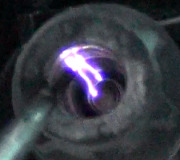Ok, let's get down to business. The Hall Effect Switch is a high failure part so it wouldn't hurt to try another one.
The first thing to check is whether the Automatic Shutdown (ASD) relay is turning on. It should turn on for one to two seconds when you turn on the ignition switch, then turn back off. There are a number of ways to tell. You might hear the whir of the fuel pump if the chime isn't too distracting. You can also listen under the fuel tank or by the filler cap when a helper turns on the switch. Chances are you'll hear the pump run since the ASD circuit is very trouble free. If you do hear it, suspect the Hall Effect switch.
If you don't hear the pump, it could be bad or it just might be quiet. GM pumps are pretty noisy; Chrysler pumps are usually very quiet. A dead pump will sometimes start up if you bang on the bottom of the tank when your helper turns on the ignition switch. If banging gets it started, it could work fine for weeks or it could act up again next time.
Another way to tell if the ASD relay is turning on is to use a test light or voltmeter to measure the voltage on the positive terminal of the ignition coil, the wire to the fuel pump, (if you can find it), one of the fuel injector wires, or the small wires on the back of the alternator. All of these should have full battery voltage for one to two seconds after turning on the ignition switch. If you have voltage for those two seconds, that also confirms the circuitry is working.
The engine computer will turn on the ASD relay again when it sees engine rotation, (cranking or running). It knows there's rotation from the pulses received from the Hall Effect switch. If you do find voltage at any of these points while cranking the engine, the Hall Effect switch is working. That's when it's time to figure out why spark is missing. Check if the distributor shaft and rotor are turning during cranking. If not, suspect a broken or stripped timing belt.
Caradiodoc
Monday, January 4th, 2010 AT 10:24 PM



